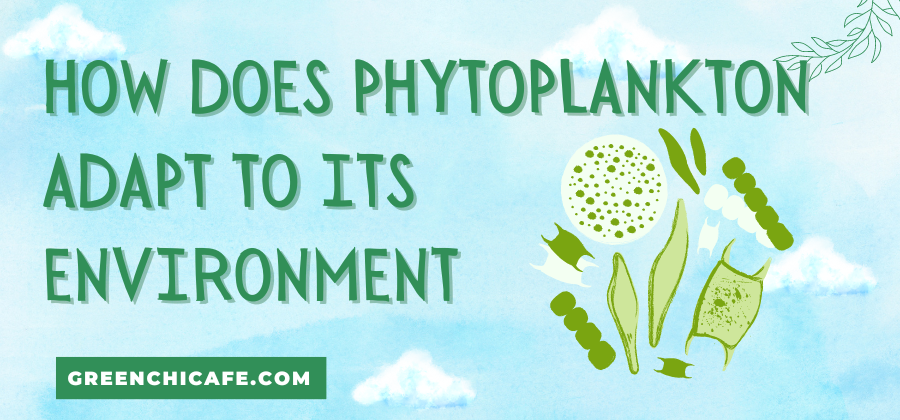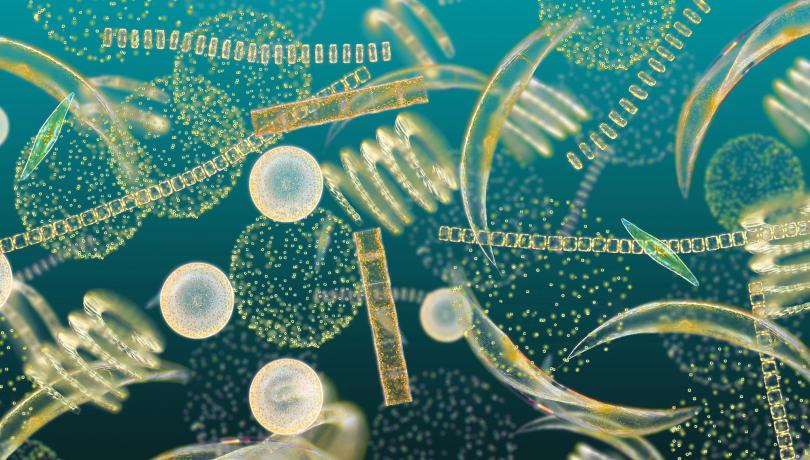Phytoplankton are the base of the marine food web and support all ocean life through photosynthesis.
Their evolutionary adaptations allow them to thrive in a dynamic environment.
This article explores how factors like temperature, light, and water chemistry shape phytoplankton communities.
How Phytoplankton Adapt to Its Environment
Phytoplankton have evolved a diverse range of adaptations that allow them to thrive in challenging aquatic environments.
These include pigment, morphological, behavioral, and physiological adaptations.
Key Points
- Phytoplankton contain accessory pigments to enhance light absorption for photosynthesis.
- Many phytoplankton have flat or elongated shapes to increase surface area.
- Phytoplankton migrate vertically in the water column to access light and nutrients.
What Are Phytoplankton?
Phytoplankton are microscopic, single-celled organisms that live suspended in aquatic environments.
There are thousands of different phytoplankton species.
They exist in both freshwater and marine systems.
Phytoplankton contain chlorophyll and require sunlight to live and grow through photosynthesis.
They are primary producers and form the base of the ocean’s food web.
Many marine animals feed directly on phytoplankton, making them essential for supporting life in the sea.
How Does Phytoplankton Adapt to Variable Temperatures?
Water temperature profoundly impacts phytoplankton growth and their geographic distribution.
Different species thrive in cold polar regions versus warm tropical waters.
Phytoplankton enzymatic processes work best within an optimal thermal range.
Temperatures outside this range slow metabolism and growth.
Some phytoplankton can physiologically adapt to temperature changes by modifying cell membranes and enzymes over generations.
Other species migrate vertically in the water column to find their temperature optimum.
Warming ocean temperatures due to climate change are causing shifts in phytoplankton community composition on a global scale.
How Do Phytoplankton Capture Enough Sunlight?
Sunlight provides the energy that phytoplankton need to photosynthesize and fix carbon.
Phytoplankton have evolved adaptations to enhance light capture in the dimly lit ocean.
Many phytoplankton contain accessory pigments that broaden the spectrum of light they can absorb.
Some species have flat or elongated shapes that increase surface area to collect photons.
Motile phytoplankton migrate vertically to remain in well-lit surface waters during the day.
In response to lower light in winter, phytoplankton increase pigment production.
Light directly impacts the rate of photosynthesis and primary production in phytoplankton.
How Does Phytoplankton Adapt to Access Nutrients?
Phytoplankton require nutrients like nitrogen, phosphorus, and iron to synthesize proteins, DNA, and chlorophyll needed for growth.
Often these nutrients are scarce in surface waters where light is abundant.
Many phytoplankton migrate down into deeper, darker waters to access nutrient reservoirs.
Some have uptake systems with very high affinities for scarce nutrients.
Nitrogen-fixing cyanobacteria can use inert nitrogen gas when inorganic nitrogen levels are low.
Nutrient availability shapes phytoplankton community structure.
Human activities are altering marine nutrient cycles in ways that negatively impact phytoplankton.
How Does Water Chemistry Affect Phytoplankton?
The chemical properties of water significantly influence phytoplankton physiology.
Salinity impacts cell osmoregulation and the availability of nutrients.
Some species tolerate only narrow salinity ranges, while others thrive in habitats spanning fresh to marine waters.
Water pH regulates essential cellular reactions and the bioavailability of CO2 for photosynthesis.
Ocean acidification due to rising atmospheric CO2 is predicted to affect phytoplankton communities.
Many phytoplankton have also evolved mechanisms for dealing with oxidative stress and heavy metal contamination in aquatic systems.
How Does Phytoplankton Compete with Each Other?
Phytoplankton species employ competitive strategies to access limited resources.
Some have rapid growth rates, allowing them to quickly dominate when nutrients and light are abundant.
Toxic phytoplankton synthesize chemicals that inhibit competitors.
Nutrient storage capabilities provide an advantage when supplies are intermittent.
Unique light-harvesting pigments expand niche space for some groups like cyanobacteria.
Viral infection is another major source of phytoplankton mortality that shapes community structure.
Ultimately, the interplay between top-down grazing pressure and bottom-up resource competition determines phytoplankton diversity.
How Does Phytoplankton Form Harmful Blooms?
Certain phytoplankton species proliferate into high-biomass blooms when conditions are favorable.
Blooms color the water green, brown, or red.
Some are comprised of toxin-producing phytoplankton and negatively impact ecosystems and human health.
Nutrient pollution from agricultural and urban runoff fuels problem blooms in coastal areas.
Climate change is increasing bloom frequency in certain regions.
Harmful algal blooms can poison marine life and force fishery closures.
Mitigating coastal nutrient inputs and limiting global warming may help control harmful blooms.
Can Phytoplankton Adapt to Climate Change?
Phytoplankton are susceptible to our rapidly changing climate.
Ocean warming, acidification, deoxygenation, and altered nutrient supplies are impacting phytoplankton globally.
Some species can evolve adaptive mechanisms, while climate-intolerant groups may decline or go extinct.
Shifts in phytoplankton community structure will cascade through marine food webs.
More research is needed to determine if and how quickly phytoplankton can adapt to climate change variables like warming and acidification.
Protecting marine ecosystems can improve the resilience of phytoplankton.
Why Are Phytoplankton So Important?
Despite their small size, phytoplankton wields global influence.
They are the base of the aquatic food web, supporting marine life from zooplankton to whales.
Phytoplankton generate over half the oxygen in our atmosphere through photosynthesis.
They also play key roles in global nutrient and carbon cycles.
Furthermore, phytoplankton help regulate our climate by taking up massive amounts of carbon dioxide.
The future health of phytoplankton populations is critical for humans and life on Earth.
How Can We Protect Phytoplankton?
Human activities seriously threaten the foundation of the ocean food web.
Phytoplankton declines could devastate marine ecosystems and life on Earth.
Reducing carbon emissions and protecting marine habitats can improve conditions for phytoplankton.
Additionally, preventing excessive nutrient runoff into coastal waters will help control harmful algal blooms.
Sustainable fishing practices and marine reserves can maintain ecosystem balance.
International cooperation and public education are key to ensuring the future productivity of global phytoplankton populations.
What Conditions Do Phytoplankton Thrive In?
Phytoplankton thrive in aquatic environments that provide optimal conditions for growth.
Two of the most important factors are sufficient nutrients and light availability.
Phytoplankton need access to nitrogen, phosphorus, trace metals, and other nutrients.
Coastal upwelling zones and deep mixing areas that bring nutrients to surface waters promote phytoplankton blooms.
Shallow nutrient-rich waters favor dense populations.
Phytoplankton also need sunlight for photosynthesis, so they flourish in well-lit, upper layers of the water column.
Many species migrate vertically to balance light and nutrient needs.
Moderate temperatures, salinity, turbulence, and water chemistry that are not extreme also favor phytoplankton growth.
Identifying conditions that allow different phytoplankton groups to thrive provides insight into community dynamics.
What Adaptations Help Plankton Remain Neutrally Buoyant?
Many plankton have evolved adaptations to achieve neutral buoyancy, allowing them to stay suspended in the water column.
One strategy is the production of oil or gas vacuoles that increase lift.
Some plankton adjusts the concentration of ions or organic solutes within cells to change density.
Others have gelatinous tissues or watery bodies that reduce overall density.
Some utilize oils and fats for buoyancy.
Motile plankton-like copepods have swimming appendages that generate lift.
Rapid cell division helps maintain populations near the surface.
Shape and body extensions increase drag.
Changing buoyancy allows plankton to remain in illuminated, productive surface waters where food is abundant and predation risks are lower.
Achieving neutral buoyancy is essential for the ecology and survival of many plankton species.
In Summary
Phytoplankton have evolved a diverse array of adaptations to permit survival in the challenging conditions of the open ocean.
Their sensitivity to environmental change makes them important sentinels for the health of marine ecosystems.
Safeguarding phytoplankton means securing our future on this ocean planet.
Frequently Asked Questions
What Is the Importance of Phytoplankton?
Phytoplankton are the most abundant photosynthetic organisms on Earth. They provide food and oxygen to marine ecosystems and influence global biogeochemical cycles.
How Quickly Can Phytoplankton Adapt?
Some phytoplankton can evolve adaptive mechanisms over generations, while others may decline if conditions change too rapidly. More research is needed on rates of adaptation.
Do All Phytoplankton Bloom?
No, only certain phytoplankton species proliferate into high-biomass blooms given optimal conditions. Blooms can be harmless or harmful.
How Are Humans Threatening Phytoplankton?
Climate change, ocean pollution, overfishing, and other human impacts are altering marine habitats and threatening phytoplankton populations globally.
At GreenChiCafe, we are passionate about the environment and our natural world. Please check out our website for more great content on important environmental topics!

Annie is a passionate environmental writer and activist. She has been writing about sustainability, conservation, and green living for over 15+ years. Annie is dedicated to raising awareness about environmental issues and providing practical tips for living an eco-friendly lifestyle. When she’s not writing, you can find her volunteering with local environmental organizations, teaching workshops on zero waste living, or exploring nature. Feel free to get in touch with Annie: annie@greenchicafe.com


